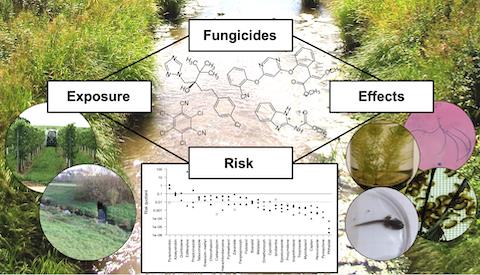In this post, Jochen Zubrod reports on their recently published paper “Fungicides – an overlooked pesticide class?”.
Fungicides are considered an indispensable measure to secure global food supply and intensification of their use is forecasted. Following their use, fungicides can enter aquatic ecosystems and, given the typically frequent, prophylactic application of these pesticides, they can occur in surface water bodies in agricultural catchments throughout the whole growing season. However, in comparison to other pesticide classes, the exposure to and effects of fungicides have received less attention.
Our review provides an overview of the risk of fungicides to aquatic ecosystems covering fungicide exposure (including environmental fate, exposure modelling, and mitigation measures) as well as direct and indirect effects of fungicides on microorganisms, macrophytes, invertebrates, and vertebrates. We show that fungicides occur widely in aquatic systems, that the accuracy of predicted environmental concentrations is debatable, and that fungicide exposure can be effectively mitigated. We additionally demonstrate that fungicides can be highly toxic to a broad range of organisms and can pose a risk to aquatic biota.

Finally, we outline seven central research gaps that currently challenge our ability to predict fungicide exposure and effects, promising research avenues, and shortcomings of the current environmental risk assessment for fungicides:
- For a more complete and reliable estimation of fungicide exposure in aquatic systems, methods other than grab sampling should be implemented. Moreover, more attention should be paid to fungicide loads of sediments and potential food sources of aquatic organisms (algae, biofilms, detritus, etc.) to capture all significant pathways of exposure
- Using conventional approaches based on concentration measurements, the processes associated with the fate of fungicides can hardly be distinguished, rendering the use of novel techniques, such as compound-specific isotope analysis or suspect/non-target analysis of transformation products, necessary. Moreover, current methods used by regulatory risk assessment to predict environmental fungicide concentrations do not provide estimations that reflect actual field exposure, rendering targeted analyses of parameters and scenarios of these approaches necessary
- More research on mitigation measures, such as vegetated treatment systems, is needed to determine how they are to be customized to satisfy local requirements
- Based on the high risk fungicides pose for aquatic fungi, the fact that ERA ignores fungi warrants reconsideration. Moreover, advancements in molecular biological analyses make fungal communities suitable models for solving major issues in stress and community ecology
- More research on indirect fungicide effects is required as they have the potential to propagate through food webs
- To test the protectiveness of regulatory acceptable concentrations, more field studies, complemented by laboratory experiments to prove causality of field associations, are required
- As the empirical testing of all species (or species assemblages) to even single fungicides, let alone considering mixtures and the environmental and management context, is unfeasible, we recommend an increase in effect modelling efforts to predict toxicity under variable environmental conditions while reducing animal testing whenever possible
The paper was authored by an international consortium including Jochen Zubrod, Mirco Bundschuh, Gertie Arts, Carsten Brühl, Gwenaël Imfeld, Anja Knäbel, Sylvain Payraudeau, Jes Rasmussen, Jason Rohr, Andreas Scharmüller, Kelly Smalling, Sebastian Stehle, Ralf Schulz, and Ralf Schäfer, and was published in Environmental Science & Technology.
